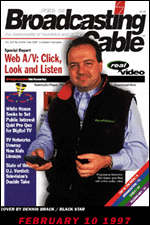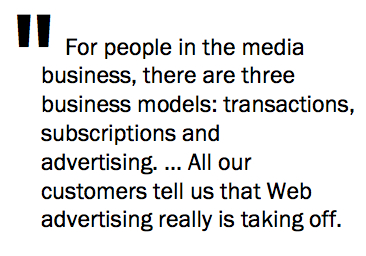 It might be hard to believe in this modern era of HTML5, HD streaming video, Netflix and Hulu, but there was a time when the web — or the World Wide Web, as we called it back then — was primarily images, text and links. Audio was cutting edge.
It might be hard to believe in this modern era of HTML5, HD streaming video, Netflix and Hulu, but there was a time when the web — or the World Wide Web, as we called it back then — was primarily images, text and links. Audio was cutting edge.
In February 1997, fifteen years ago this past week, a company in Seattle called Progressive Networks started to change that with the release of the technology called RealVideo, opening eyes to the possibilities of a web that delivered rich streaming content.
It was, as the company described it at the time, the “first feature-complete, cross-platform video broadcast solution for the web.”
Later that year, Progressive Networks renamed itself RealNetworks. The company has survived to this day, and it’s currently at a crossroads, with a new CEO reshaping and hoping to revive its business.
In recognition of the RealVideo milestone, GeekWire dug through the Seattle Public Library’s online archives and found a classic Broadcasting & Cable interview with Rob Glaser, the company’s founder (and still its chairman), who was the subject of the magazine’s Feb. 10, 1997 cover story.
Here are a few excerpts, for your weekend entertainment.
How long will it be until a significant number of people have 56 kilobit modems and the ability to access video?
Glaser: Two years ago, 14.4 four modems were the standard, and 28.8 was just coming. Since then, 28.8 has completely taken over. Two years from now 56 will probably be in at least as strong a position as 28.8 is today. So where in that two-year period does 56 become something that everybody that logs onto America Online has? The optimist would say three to six months. A more realistic view might be nine to 12 months.
We’ve used the beta test versions of these modems. And they work. They’re very exciting. They’re still getting the kinks out, but it’s a real phenomenon and it’s something that makes now the right time to launch video on the Internet.
When does this become a threat to broadcasters? Or something that will dramatically change the industry?
 Glaser: I don’t think it will imperil broadcasting or cable in the next three to five years, maybe even seven to 10 years. When the Wright brothers flew at Kitty Hawk in 1903 it didn’t unleash the commercial aviation business. But it unleashed a paradigm shift that ultimately led to big changes. Now is the time for people who are current stakeholders in the industry-as well as new entrepreneurs-to really understand how to use this media. We’re starting to see on the Web some businesses using advertising-supported models and certain kinds of transactional businesses that are working as standalone businesses in small-scale entrepreneurial ways. By adding video, we’ll enrich those businesses and we’ll also start another phase of experimentation.
Glaser: I don’t think it will imperil broadcasting or cable in the next three to five years, maybe even seven to 10 years. When the Wright brothers flew at Kitty Hawk in 1903 it didn’t unleash the commercial aviation business. But it unleashed a paradigm shift that ultimately led to big changes. Now is the time for people who are current stakeholders in the industry-as well as new entrepreneurs-to really understand how to use this media. We’re starting to see on the Web some businesses using advertising-supported models and certain kinds of transactional businesses that are working as standalone businesses in small-scale entrepreneurial ways. By adding video, we’ll enrich those businesses and we’ll also start another phase of experimentation.
Is it possible that this will never become a mass medium? Only the people with the best computers, the fastest modems, will ever really get a chance to use this. That’s a few million people at any given moment.
Glaser: This becomes a mass medium surprisingly quickly for a couple of reasons. Number one, the rate of innovation is so great, 1995’s leading edge computer is 1997’s mainstream computer and 1998’s behind-the-curve computer. So today’s cutting-edge machines are tomorrow’s mainstream computers. The second thing is that there’s a category of devices that we’re very excited about: TV appliances. Web TV is the best known of them. It’s the one that’s being promoted, but there are companies like Naveo, a Netscape spinoff, and Oracle’s Network Computing that are working on these.
This is the question everybody asks about the Internet: How do you make money with it?
Glaser: For people in the media business, there are three business models: transactions, subscriptions and advertising. One could bundle subscriptions and transactions if the goods that you’re delivering are bits, rather than atoms. Advertising is clearly on a roll. Our ad revenue from our site more than doubled between the third and the fourth quarter of last year and we see rapid growth continuing for that part of our business. All our customers tell us that Web advertising really is taking off.
(Thanks to Andy Boyer for pointing out the anniversary.)



